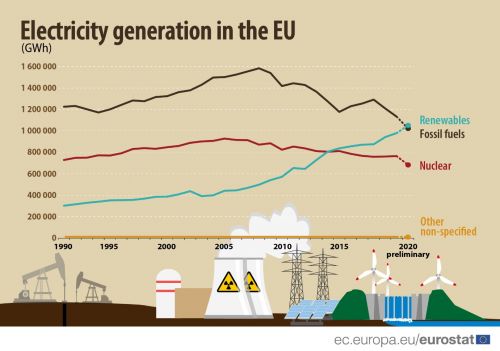Archive:Energy balances - early estimates
Data extracted in June 2021.
Planned update: 29 June 2022.
Based on preliminary 2020 data for the EU, more electricity was generated from renewables than from fossil fuels.
Based on preliminary 2020 data for the EU, the use of coal decreased by 20%, following a similar decrease in year 2019.
Based on preliminary 2020 data for the EU, the gross inland deliveries of petroleum products decreased by 13% and reached the lowest levels since 1990.
Highlights
This article presents the 2020 preliminary data for energy commodities, estimating the evolution of the energy supply across the EU in 2020 as compared with 2019. Reporting countries transmit their preliminary annual energy data on a voluntary basis within 5 months after the end of the reference year to Eurostat. This improved timeliness is the result of Eurostat’s response to policy needs, and reporting countries have significantly contributed to achieving these results. Final annual energy data is published by Eurostat 13 months after the end of the reference period (final 2020 data will be available by the end of January 2022). The sections below present the highlights for the EU aggregate. MS Excel files at the end of this article include all detailed national data for the supply side[1] of energy commodities.
It would hardly be an overstatement to claim that the year 2020 brought about some radical changes in our lives and economies. National lockdowns and restrictive measures introduced to curb the spread of COVID-19 forced businesses to close, imposed working from home for a large number of workers, and drastically reduced human mobility. This, unsurprisingly, had a tremendous impact on our energy consumption on a monthly basis, as shown in the article Energy statistics - latest trends from monthly data[2], which presents monthly energy data from 2020. We will see in the following sections, however, that these major monthly fluctuations were mostly offset throughout the year, and we do not see that many drastic changes compared to 2019 – the total electricity supply, for example, decreased overall by 4 %, derived heat supply by 3.4 %, while natural gas supply dropped by 2.6 %. The two categories that did not experience a rebound are petroleum products, with gross inland deliveries dropping by as much as 13 % compared to 2019 on the EU level, and coal, with brown coal decreasing by 20 % and hard coal by 18 %.
Figure 1 shows the contribution of different fuels to electricity generation in the EU. Preliminary data suggest that, in 2020, more electricity was generated from renewables than from fossil fuels.
Full article
Solid fossil fuels (coal) and manufactured gases
Similarly to the developments observed in 2019 and in line with the EU climate-related policies, preliminary 2020 data indicate a significant year-on-year decrease in the supply and inland consumption of coal. In general, solid fossil fuels in 2020 are expected to be on a record low level since data are available (i.e. since 1990). Inland consumption of lignite in the EU decreased by 61 million tonnes (Mt) (-19.9 %), other bituminous coal dropped by 24.8 Mt (-20 %), oil shale and oil sands by 3.9 Mt (-24.7 %), coking coal by 6 Mt (-12.5 %), and coke oven coke by 4.6 Mt (-14.8 %).These solid fossil fuels, being the most represented in the solid fossil fuels total, drive the overall downward trend in supply and consumption. Importantly, all the other solid fossil fuels follow the same trend, albeit less pronounced. Manufactured gases, mostly produced in relation to coal consumption in iron and steel industry, decreased significantly as well. These data are presented in Table 1. The MS Excel file available at the end of the article provides details on indigenous production, imports, exports and stock changes for each type of coal, as well as country specific data.

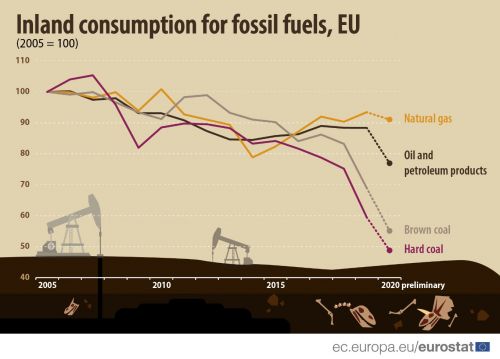
Figure 2 shows the trend in fossil fuels. Preliminary data suggest a continuation of significant decreases for coal in 2020.
Natural gas
Preliminary 2020 data indicate a further significant decrease in the domestic production of natural gas (-21.2 % compared to 2019). Combined with these production developments, a drop in both imports and exports resulted in a 2.6 % decrease in the inland consumption of natural gas (see Table 2). The MS Excel file available at the end of the article provides details for each country. According to these preliminary data, Sweden saw by far the biggest increase in inland consumption of natural gas (+32.9 %), followed by Greece (+9.8 %), Romania (+7.8 %), and Lithuania (+5.8 %). On the other hand, Latvia reported the sharpest decrease in inland consumption of natural gas (-17.5 %), followed by Denmark (-13.4 %), Spain (-9.7 %), and Luxembourg (-8.9 %). Cyprus was still the only EU country without any natural gas consumption, while the Netherlands remained the biggest natural gas producer in the EU, with 873 PJ of indigenous production.
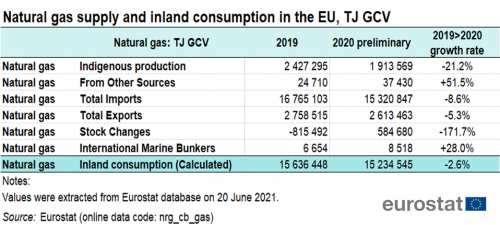
Oil
Preliminary 2020 data indicate that the demand of refineries for primary oil (such as crude oil) decreased significantly: -11.7 % for calculated refinery intake and -12.0 % for observed refinery intake (see Table 3). A similar trend (-12.5 %) was also observed for the supply of refined petroleum products from refineries (see Table 4). Gas/diesel oil followed by motor gasoline were the most significant oil products refined in the EU, accounting for 60 % of the total refinery output in 2020. The gross inland deliveries of all petroleum products to the EU market show a sharp decrease in 2020 (-13 %). The preliminary data suggest that gross inland deliveries of transport fuels (motor gasoline, gas/diesel oil, LPG and kerosene type jet fuel) dropped substantially compared to 2019. Unsurprisingly given the 2020 context, by far the biggest decrease is observed for non-bio jet kerosene (-52.4 %). Naphtha and fuel oil were also on the decrease, dropping by 5.6 % and 20.7 %, respectively. More details and country specific preliminary data are available in the MS Excel file for oil.

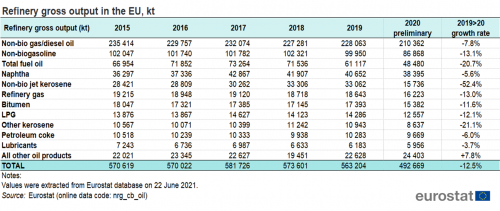
Electricity & heat
The total electricity supply in the EU decreased by 4.0 % compared to 2019. Preliminary data indicate significant annual variations between various fuel sources. As expected, the renewable category mostly saw increases and in its totality surpassed fossil fuels. Preliminary 2020 data show the biggest increases in electricity produced from solar energy (+15.5 % or 19.5 TWh) on the EU level, followed by wind (+8.2 % or 29.9 TWh), and hydro (+8.1 % or 28.0 TWh). Solid biofuels, on the other hand, show a slight decrease (-2.7 %), whereas geothermal energy and biogases at this stage seem quite stable. There were no significant changes in the production of electricity from natural gas (-0.5 % or -2.8 TWh). At the same time, however, electricity generation from solid fossil fuels dropped substantially in 2020: other bituminous coal (-25.9 % or -52.5 TWh) and lignite (-18.9 % or -45.7 TWh). In comparison with 2019, the output of nuclear power plants decreased by 10.7 % in 2020 (-82.2 TWh). The biggest contributors to the EU electricity generation system in 2020 were nuclear (683 TWh), natural gas (566 TWh), wind (397 TWh), hydro (373 TWh), lignite (195 TWh), other bituminous coal (150 TWh), and solar (145 TWh). Renewables in total (1 053 TWh) were the biggest contributor as an individual fuel group, contributing for the first time more than fossil fuels in total (1 023 TWh).

The total derived heat supply in the EU in 2020 is estimated to have decreased by 3.4 % compared to 2019. Natural gas as the most important fuel for heat production in the EU saw a decrease of 1.9 % or 15.6 PJ. Looking at all fossil fuels together, preliminary data indicate a drop in heat production by 6.5 % or 93 PJ. Solid biofuels, the second largest contributor to heat production, decreased slightly by 0.9 % or 4.2 PJ, whereas heat from wastes (industrial waste and renewable/non-renewable municipal waste) increased by 3.9 % or 3.3 PJ. Other sources contribute significantly less to the total heat production, and preliminary data indicate mixed trends. More details and country specific preliminary data are available in the MS Excel file at the end of the article.
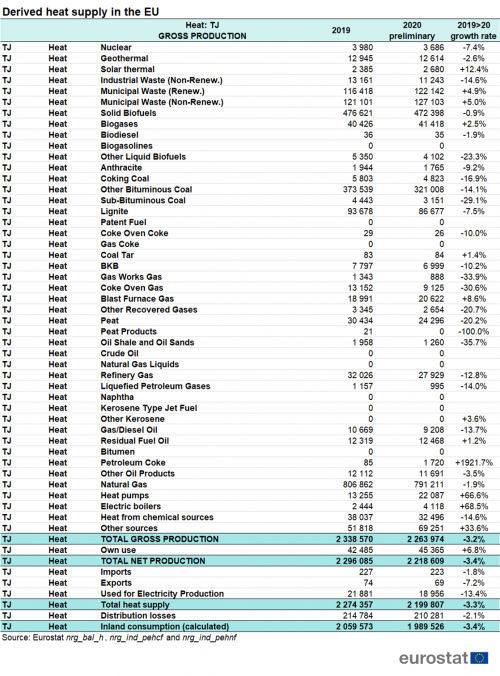
Renewables and waste
Preliminary 2020 data indicate that the use of renewable energies increased in 2020. As seen in Table 5, electricity generated from several renewable sources recorded relatively high increases (solar +15.5 %, wind +8.2 %, hydro +8.1 %, tide, wave and ocean +2 %). There were also some decreases in electricity production from certain renewables, but none of them significant: geothermal -0.4 %, solid biofuels -2.7 %, other liquid biofuels -2.1 %. Table 7 shows that the use of both industrial and municipal waste for energy purposes slightly increased (non-renewable industrial waste +1.9 %, renewable municipal waste +0.8 %, non-renewable municipal waste +1.2 %). Supply of charcoal continued its downward trend and was 15.1 % lower than in 2019. Supply of biodiesels and biogasoline remained relatively stable, whereas other liquid biofuels dropped by 5.4 %. Preliminary data also indicate a decrease in the use of solar thermal energy (-4.1 %) and marginally in geothermal energy (-0.2 %) in 2020. More details and country specific preliminary data are available in the MS Excel file for renewables and waste.
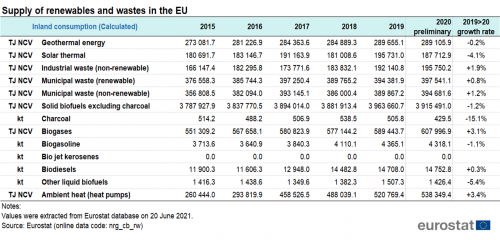
Source data for tables and graphs
 Download Excel file with 2020 preliminary data for electricity
Download Excel file with 2020 preliminary data for electricity Download Excel file with 2020 preliminary data for heat
Download Excel file with 2020 preliminary data for heat Download Excel file with 2020 preliminary data for solid fossil fuels (coal) and manufactured gases
Download Excel file with 2020 preliminary data for solid fossil fuels (coal) and manufactured gases Download Excel file with 2020 preliminary data for renewables & wastes
Download Excel file with 2020 preliminary data for renewables & wastes Download Excel file with 2020 preliminary data for oil (crude oil and derived oil products
Download Excel file with 2020 preliminary data for oil (crude oil and derived oil products Download Excel file with 2020 preliminary data for natural gas
Download Excel file with 2020 preliminary data for natural gas
Data sources
Methodology
Timeliness and accuracy of the input data Currently, the official energy annual data (the European statistics on energy) is published in a harmonised form of commodity/energy balance by Eurostat 13 months after the end of the reference period (2015 data were available at the end of January 2017, 2016 data were available at the end of January 2018, etc.). Consequently, in the documents of the Energy Union Report from November 2015, the latest data available cover the reference year 2013, i.e. almost 2 years after the end of the reference period or "year-2". This is not optimal for a proper monitoring process and it is therefore essential to find ways to reduce this 'gap'. This could be achieved in several different ways:
- by finding solutions for improving the timeliness and accuracy of the existing statistical annual data collections
- by developing suitable new statistical data collections
- by estimation/modelling techniques.
Timeliness, quality control and continuity of the monitoring process The process of aggregating input data in order to produce relevant indicators is complex. It requires the collection of data, their validation and aggregation into indicators, all of this in a timely and accurate manner. The compilation and analysis in this process is time-consuming and efforts are needed to further automatize the process in order to efficiently provide high quality results. There is a strong need to have a database for ensuring the continuity of the monitoring process over time. Therefore some developments are necessary in order to reduce the administrative burden of the process, to avoid potential human errors when processing data into indicators and to increase flexibility to cope with potential changes in the monitoring process or indicators.
Transparency of the monitoring process The monitoring process should be done in a transparent manner. In other words, the indicators should be publicly available in an easily understandable visual presentation (including graphs and data tables) together with the calculation/estimation methodology.
The development of solutions The European Commission (DG Energy and Eurostat) is developing short-term and long-term solutions. During 2016, DG Energy undertook an exploratory study to try to identify ways of having early estimates or earlier preliminary data on 2015 energy consumption. The future activities of DG Energy are planned to be complementary to Eurostat deliveries – whenever available, official statistics will be used as the primary source of information.
Eurostat response to policy needs In March 2016 Eurostat initiated an intensive cooperation with the reporting countries in the Energy Statistics Working Group (ESWG) and launched the Energy Statistics Task Force on Early Estimates of Energy Balances. This cooperation resulted in the dissemination of preliminary data[3] of the 2017 supply side of the energy balance in July 2018, i.e. 7 months after the end of the reference period. For the years 2018 and 2019, the preliminary supply side data were published in June 2019 and June 2020, respectively, i.e. 6 months after the end of reference period. The published data are to be considered preliminary and are revised upon the delivery of data as defined in Regulation (EC) No 1099/2008 on energy statistics. Further developments in the upcoming years are planned on delivering estimates of the key aggregates of the consumption side of energy balance. Together with the reporting countries, Eurostat will develop a methodology to produce early estimates of energy balances and will further analyse their accuracy. When the high quality of the results is confirmed, Eurostat will complement the dissemination of commodity balances with the early estimates of energy balances.
The methodology Data collection (including possible estimation) is done at the national level by the respective National Statistical Institutes or Other National Authorities transmitting data to Eurostat. Eurostat does not publish any estimates for values not transmitted by individual reporting countries. However, for the purpose of presenting the EU aggregate, some missing values need to be estimated for a very limited number of reporting countries. These Eurostat estimates are not present on the data sheets with national data and were used only for the improvement of the accuracy of the EU aggregate.
The results The MS Excel files below include all national results. These data should be considered as preliminary for the reference year 2020; these are not final data for policy evaluation or official monitoring of developments towards legally binding targets.
The limitations The exercise on developing early estimates of energy balances is currently under development by Eurostat and the Energy Statistics Task Force on the Early Estimates of Energy Balances. It is yet to be seen if the preliminary data provided by reporting countries can be used only to create an accurate estimate of the supply side of the energy balance or also the estimate of the consumption side of the energy balance. Eurostat, in pursuing the approach of full transparency, publishes the collected data (the input into the project in the form of the so called "mini-questionnaires"). Thus the limitations as for any statistics under development should apply also for these data.
Context
The European Green Deal and the Energy Union
The need for energy balances earlier. The European Green Deal, adopted by the Commission on 11 December 2019, is an ambitious EU climate policy that aims for Europe to become the first climate-neutral continent by 2050. This requires a fundamental transformation of our energy system, which can only be achieved through a combination of coordinated action – legislative and non-legislative – at EU and national level. The Energy Union is the main energy policy instrument to deliver the transformations required to decarbonise our energy system. The Energy Union strategy has mutually reinforcing and closely interrelated dimensions designed to bring greater energy security, sustainability and competitiveness. The aim of the Energy Union is to provide a new integrated, cooperative and more effective framework for common EU energy and climate policies providing secure, affordable, competitive and sustainable energy to the European consumers – households and businesses. The first State of the Energy Union report stated the following: "In order to track progress, a transparent monitoring system has to be put in place based on key indicators as well as on Member States' biannual reports concerning progress made on their national plans. The Commission intends to assess collective progress made at the EU level in its annual State of the Energy Union and, if necessary, propose policy actions and measures to ensure the delivery of the Energy Union objectives". Using reliable high quality data to monitor the progress made to achieve the Energy Union and European Green Deal targets will enhance the credibility of the EU energy policy, therefore official statistics need to contribute to this process to remain relevant and aligned to the needs of our policy-makers and society. The energy data presented in this article support this monitoring.
Direct access to
- Energy (nrg), see:
- Energy statistics - quantities (nrg_quant)
- Energy statistics - quantities, annual data (nrg_quanta)
- Supply, transformation and consumption - commodity balances (nrg_cb)
- Supply, transformation and consumption of solid fossil fuels (nrg_cb_sff)
- Supply, transformation and consumption of gas (nrg_cb_gas)
- Supply, transformation and consumption of oil and petroleum products (nrg_cb_oil)
- Supply, transformation and consumption of renewables and wastes (nrg_cb_rw)
- Supply, transformation and consumption of electricity (nrg_cb_e)
- Supply, transformation and consumption of derived heat (nrg_cb_h)
- Energy indicators (nrg_ind)
- Gross production of electricity and derived heat from combustible fuels by type of plant and operator (nrg_ind_pehcf)
- Gross production of electricity and derived heat from non-combustible fuels by type of plant and operator (nrg_ind_pehnf)
- Supply, transformation and consumption - commodity balances (nrg_cb)
- Energy statistics - quantities, annual data (nrg_quanta)
- Energy statistics - quantities (ESMS metadata file: European and national metadata)
- Supply, transformation and consumption - commodity balances (ESMS metadata file)
- Energy sbalances (ESMS metadata file)
- Regulation (EU) 2018/1999 on the Governance of the Energy Union and Climate Action
- Regulation (EC) No 1099/2008 on energy statistics
Notes
- ↑ The preliminary annual data that Eurostat publishes within the framework of this voluntary exercise concerns energy supply. In this article we use the terms supply and inland consumption interchangeably, since the calculated inland consumption corresponds to the supply.
- ↑ At the time of writing this, the article Energy statistics – Latest trends from monthly data refers to 2020. However, as monthly data for the previous year is available to Eurostat before preliminary annual data, which this article is based on, the reader should bear in mind that in early 2022 the referenced article may have already been updated with monthly data from 2021.
- ↑ While most countries provide preliminary data, some countries are able to provide final data and other countries can provide estimates.
